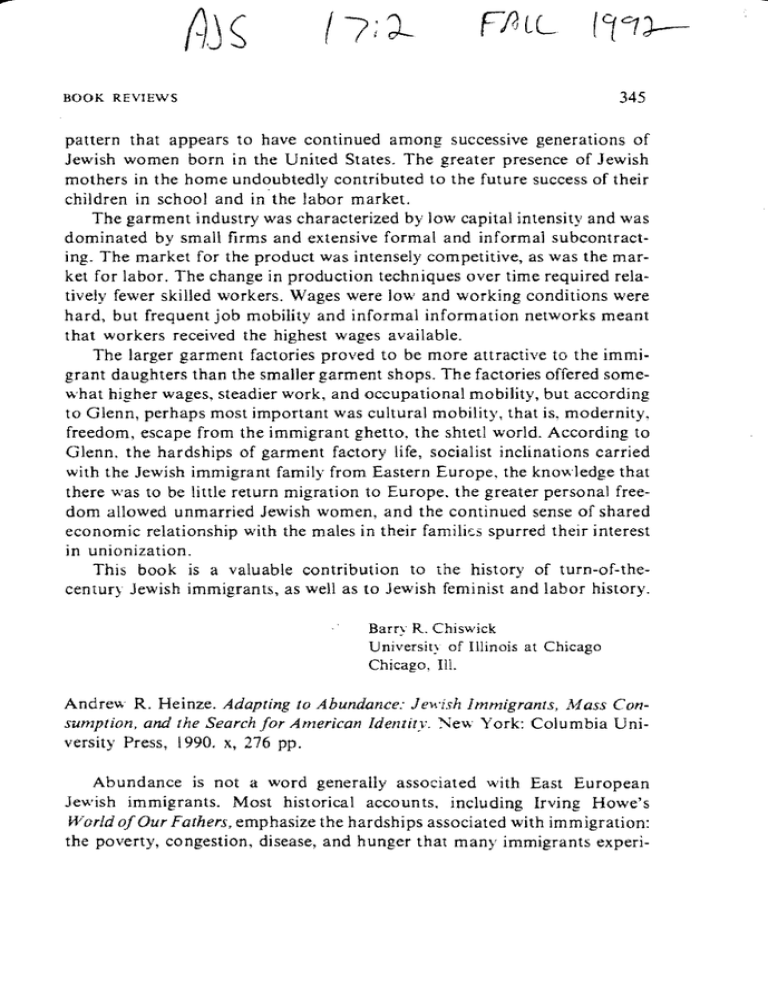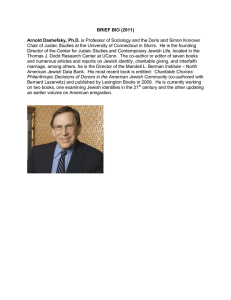FALL
advertisement

FALL 345 BOOK REVIEWS pattern that appears to have continued among successive generations of Jewish women born in the United States. The greater presence of Jewish mothers in the home undoubtedly contributed to the future success of their children in school and in the labor market. The garment industry was characterized by low capital intensity and was dominated by small firms and extensive formal and informal subcontracting. The market for the product was intensely competitive, as was the mar· ket for labor. The change in production techniques over time required relatively fewer skilled workers. Wages were low and working conditions were hard, but frequent job mobility and informal information networks meant that workers received the highest wages available. The larger garment factories proved to be more attractive to the immigrant daughters than the smaller garment shops. The factories offered somewhat higher wages, steadier work, and occupational mobility, but according to Glenn, perhaps most important was cultural mobility, that is, modernity, freedom, escape from the immigrant ghetto, the shtetl world. According to Glenn. the hardships of garment factory life, socialist inclinations carried with the Jewish immigrant family from Eastern Europe, the knowledge that there was to be little return migration to Europe. the greater personal freedom allowed unmarried Jewish women, and the continued sense of shared economic relationship with the males in their familics spurred their interest in unionization. This book is a valuable contribution to the history of turn-of-thecentury Jewish immigrants, as well as to Jewish feminist and labor history. Barry R. Chiswick University of Illinois at Chicago Chicago, Ill. Andrew R. Heinze. Adapting to Abundance: Jewish Immigrants, Mass Consumption, and the Search/or American Identity. ~ew York: Columbia University Press, 1990. x, 276 pp. Abundance is not a word generally associated with East European Jewish immigrants. Most historical accounts. including Irving Howe's World o/Our Fathers, emphasize the hardships associated with immigration: the poverty, congestion, disease, and hunger that many immigrants experi- 346 BOOK REVIl,WS ef'scd during their first years on American soil. In this volume, however, Andrew Ileillie argues that abundance too played a formative role in immigram Jewish lile. When eastern European Jews arrived in America, they encountered not only a host of new products but a new perspective that was intimately related to the fact of material abundance. In adopting the American standard of living, they would inevitably be adapting to a characteristically American attitude. As consumers, then, they would lay the foundation of an American identity. (p. 42) Heinze focuses on the "culture of consumption" in the American Jewish immigrant community. His best chapters cover such usually neglected subjects as clothing, leisure, "the parlor and the piano," and American advertising in the Yiddish press. In another chapter, he reinterprets the role of the Jewish woman from this perspective, arguing that she was, as a baleboste, the "manager of domestic consumption." Patterns of consumption also serve, according to Heinze, to distinguish Jews from Gentiles, and immigrants from those who stayed behind in Europe. Heinze concedes from the outset that "some rough edges have inevitably been smoothed out" in his analysis. He contends, I think wrongly, that "whereas the experience of human beings is full of contradictions and am biguity, the task of historical analysis demands passionate and almost singleminded attention to one focal point of life" (p. 13). Single-factor analysis, however, is fraught with problems, and some emerge here. The chapters on American Jewish religious life, for example, argue that material abundance contributed to the decline of Jewish Sabbath observance. Whereas in Europe, Sabbath observance had been reinforced by "the selective use of luxuries," Heinze claims thai in America, "where luxuries were routinely transformed into necessities, material objects ceased 10 serve this spiritual purpose ... the lure of consumption hastened the decline of traditional Judaism, which culminated in the conversion of the Sabbath into a shopping day" (p. 220). Olle is hardpressed to accept this argument, although Heinze repealS it several times, for it was, in fact, the absence of abundance-the need to secure a job in an environment where Sabbath meant Sunday and everyone worked a six-day week-that did more than anything else to destroy Sabbath observance among immigrants. Moreover, material objects never ceased to serve spiritual purposes among American Jews; old luxuries 347 HOOK REVIEWS were simply replaced by newer and more expensive ones-witness the contemporary renaissance of Jewish ritual arl. I n some cases, abundance actually made possible a significant strengthening of Jewish religious life, particularly in Orthodox circles. In other cases, displays of abundance themselves became a form of Jewish religious observance, particularly at times of celebration and in the rituals connected with philanthropy. Heinze stands on firmer ground in most of his other chapters, and there is no question but that he has enriched our understanding of America's impact on Jewish life. Significant questions remain, however, that one hopes that Heinze or some other scholar will take up. Thus, more attention needs to be paid to historical patterns of consumption among American Jews: what changed over time and what did not. We also need a more nuanced analysis of how abundance affected Jewish life: what it destroyed, what it transformed, what it democratized-and, in each case, why. Finally, we need to fit the themes that Heinze explicates into the larger framework or American Jewish social, economic, and cultural history. This will enable us both to see change over time (what happened, for example, during periods or economic decline?) and to relate consumption to other factors thatHeinze's singleminded focus notwithstanding-were simultaneously transforming American Jewish life, both from within and from without. Jonathan D. Sarna Brandeis lJ nivcrsily Waltham, Mass. Judith Friedlander. Vilna on the Seine: Jewish Intellectuals in France Since 1968. New Haven: Yale University Press, 1990. xv, 249 pp. The general topic of the revival of Jewish identity among youth over the past three decades is standard fare in scholarly discussions of contell1 porary Jewry. The search for "roots" by young French Jewish intellectuals in the 1970s and I980s, however, presents distinctive problems and challenges that have been largely ignored by social scientists and historians. As Judith Friedlander suggests in her work under review, though mirroring many of the experiences of young American Jews of the period, including the rediscovery of eastern European Jewry and the trauma of the Six-Day War, leaders of the Jewish revival in France were by and large products of the student




